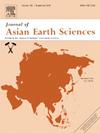Structural Heterogeneity and Seismogenesis of the National Capital Region NCR-Delhi, India
IF 2.7
3区 地球科学
Q2 GEOSCIENCES, MULTIDISCIPLINARY
引用次数: 0
Abstract
The local earthquake tomography technique has been applied to determine seismic velocities (Vp and Vs) and Poission’s ratio (ϭ) to unravel the connection between the variability of structural heterogeneities and seismogenesis with reference to seismotectonic of the National Capital Region (NCR) of India. This investigation analyzed about 6000 direct phase arrival data for crustal earthquakes recorded by 26 seismic stations ascribed to the National Seismological Network of India. We observed that the seismogenic structures are closely aligned with the sub-surface geological and tectonic patterns. Structural heterogeneities in high seismic velocities (Vp, Vs) and low Poisson’s ratio (ϭ) are associated with in-situ geological structures at depths < 30 km, where seismicity is concentrated conspicuously. This suggests that the competed rocks at shallow depths may be capable of seismogenesis in the area where most earthquakes occur. Specifically, ridges of the NCR inferred low Vp, Vs, and a high ϭ at deeper depths > 30 km, suggesting underneath geological formations associated with potentially fluid-filled rock matrix. In contrast, areas with several fault dispositions exhibited high Vp, Vs, and low ϭ, suggesting the competency for brittle failure. The seismic events are prevalent across various velocity zones but are much pronounced in areas with high ϭ, from which we infer that seismogenesis of the NCR-Delhi is dictated by weaker structural heterogeneities associated with fluid-filled rock matrix having interlinkages with past river microchannels containing fluids at depths where a majority of earthquakes occurred.
印度首都地区NCR-Delhi的结构非均质性和地震成因
应用局部地震层析成像技术确定地震速度(Vp 和 Vs)和波密比(ϭ),参照印度国家首都地区(NCR)的地震构造,揭示构造异质性的变化与地震发生之间的联系。这项调查分析了归属于印度国家地震台网的 26 个地震台记录的约 6000 个地壳地震直接相位到达数据。我们观察到,震源结构与地下地质和构造模式密切相关。高地震速度(Vp、Vs)和低泊松比(ϭ)的构造异质性与 30 千米深处的原位地质构造有关,地震集中在这些地方。这表明,在地震多发地区,浅层的竞争岩可能具有成震能力。具体而言,北部地区的山脊推断出较低的 Vp、Vs 值,以及较深 > 30 千米处较高的ϭ 值,这表明在地质构造之下可能存在充满流体的岩石基质。与此相反,有多个断层分布的地区则表现出高 Vp、Vs 和低ϭ,表明有能力发生脆性破坏。我们由此推断,德里北部研究区的地震发生是由较弱的结构异质性决定的,这些结构异质性与充满流体的岩石基质有关,在大多数地震发生的深度,这些岩石基质与过去含有流体的河流微通道相互连接。
本文章由计算机程序翻译,如有差异,请以英文原文为准。
求助全文
约1分钟内获得全文
求助全文
来源期刊

Journal of Asian Earth Sciences
地学-地球科学综合
CiteScore
5.90
自引率
10.00%
发文量
324
审稿时长
71 days
期刊介绍:
Journal of Asian Earth Sciences has an open access mirror journal Journal of Asian Earth Sciences: X, sharing the same aims and scope, editorial team, submission system and rigorous peer review.
The Journal of Asian Earth Sciences is an international interdisciplinary journal devoted to all aspects of research related to the solid Earth Sciences of Asia. The Journal publishes high quality, peer-reviewed scientific papers on the regional geology, tectonics, geochemistry and geophysics of Asia. It will be devoted primarily to research papers but short communications relating to new developments of broad interest, reviews and book reviews will also be included. Papers must have international appeal and should present work of more than local significance.
The scope includes deep processes of the Asian continent and its adjacent oceans; seismology and earthquakes; orogeny, magmatism, metamorphism and volcanism; growth, deformation and destruction of the Asian crust; crust-mantle interaction; evolution of life (early life, biostratigraphy, biogeography and mass-extinction); fluids, fluxes and reservoirs of mineral and energy resources; surface processes (weathering, erosion, transport and deposition of sediments) and resulting geomorphology; and the response of the Earth to global climate change as viewed within the Asian continent and surrounding oceans.
 求助内容:
求助内容: 应助结果提醒方式:
应助结果提醒方式:


